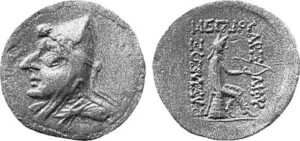The reign after Aškān I is poorly documented. However, out of the sources and information at hand, we can gain important insights into the early era of the Arsacids under Aškān II, Friapāt and Frahāt I.
A Narrative by Varan
Succession
After the natural death of Aškān I in 211 BC, his son Aškān II continued the affairs of state. Little is known about this early period. What is certain is that after Aškān II the throne was continued by the line of Tirdat, the uncle of Aškān II and the brother of Aškān I. Thus Friapāt (gr: Phriapatius), Tirdat’s son, took over the throne and the affairs of state after his cousin Aškān II. This ruler was followed by his son Frahāt I (gr. Phraates I), who ruled the state until 171 BC.
Early Character of Arsacid Statehood
The first Parthian kings, up to and including the Arsacid king Frahāt I, were mainly concerned with building up the newly established state on the previously reconquered territories. This epic phase symbolizes a modest era of the Parthians, still free of any ambitions of power politics or dynasty-political affairs. Until and with Mihrdat II, the character of the empire remained, if one may say so, authentic. That is, Mithraistic and nomadic Erano-Aryan traits embodied by the first Parni-Parthian leaders still held strong appeal. Indications of greed for power, wealth, and possessions do not seem to primarily determine actions. The still nomadic Arsacids, in contrast, seemed to prioritize family ties, military discipline, self-reliance, success through one’s own efforts, and other Mithraic virtues.
Thus, out of respect for the circumstances, Frahāt I chose his brother Mihrdat as his successor instead of favoring his sons. This decision, as can be seen later, was probably made by Frahāt I because his brother, with his strong character traits, was the more worthy successor to lead the state. This unusual passing on of power to a brother due to the more positive assessment of the leadership competence, instead of to a descendant, testifies to a value-led society or dynasty, which was due to its nomadic-warrior origin still far away from centralistic-urban affairs such as inheriting possession and the like.

Fig. 1: Portrait head, in Krybasia, left. King as archer, holding bow, seated, right. Phriapatus or Phraates I. Sylloge Nummorum Graecorum.
Warrior Kings
Likewise, a natural way of life and respect for nature were peculiar to the kings and characterized their behavior. A noticeably high number of the kings died in battles, but also because of diseases or old age. Warriorship and nomadism were characteristic of these first Parthian kings. A vivid example is the self-sacrifice and efforts of the later Parthian king Frahāt II , who had to fight in a two-front battle on the one hand against the Seleucids in the west, on the other hand directly afterwards against the Sakas in the east. To fight the battles, he traveled all throughout Parthia from the west to the east and finally fell against the Sakas in 127 BC.


